In June 2018, the idea that Bordeaux had a very good vintage on its hands was laughable. The first half of the year had seen incessant rain in the region. Mildew was rife and vignerons were fighting it all day long, including at weekends (if they could afford to). At Château Corbin, owner Anabelle Cruse cancelled her trip to Vinexpo Hong Kong to be on site to manage treatments. “We couldn’t afford any mistakes after losing nearly all of the 2017 vintage [to frost],” she said.
But then on 18th June, the weather turned, and barely another drop of rain fell until September. 2018 was a year of extremes for Bordeaux. “It started hellish, and finished in ecstasy,” said Sara Lecompte Cuvelier, Managing Director at Léoville-Poyferré. “It started a nightmare and finished a dream,” echoed Guillaume Pouthier, Director at Carmes Haut-Brion.
Against all odds, some truly extraordinary wines were made. “Technically, it’s the most accomplished wine we have made since I joined,” said Nicolas Glumineau, Managing Director of Pichon Comtesse since 2012. Adrien Bernard declared, “the 2018 [red] is the greatest wine my dad has made” – the Bernard family bought Domaine de Chevalier in 1983. But 2018 was not a great vintage across the board like 1982, 1989, or 2010. It wasn’t a vintage where you could make a great wine with your eyes closed. On the contrary, 2018 is a vintage where human choices really mattered, and at the top level, happily, these choices were usually the right ones.
 Happy with their 2018s: Guillaume Pouthier, Pierre-Olivier Clouet, and Nicolas Glumineau
Happy with their 2018s: Guillaume Pouthier, Pierre-Olivier Clouet, and Nicolas Glumineau
Concentration in the 2018s is at unprecedented levels: grapes were lost to mildew in the spring, and then the summer drought left remaining berries very small, without much juice. Picking dates were key: the temptation to leave the grapes hanging in the Indian summer was strong, but success in 2018 was all about retaining freshness to counter the high levels of alcohol and tannin.
Even those who picked early were still facing unknown territory. Many producers recounted the topsy turvy ratio of marc to juice in the vats (more skins and pips than liquid). As a result, tannin levels were off the scale, with IPTs (Indice de Polyphénols Totaux) at their highest ever recorded for many producers. At Lynch-Bages, Technical Director Nicolas Labenne explained that, “a normal IPT would be 70, a good year is 80, and we’re at 95 in 2018.”
“But it’s the quality of the tannins that’s important,” Pouthier reminded us. This colossal potential needed taming by the winemakers if they were to make gentle giants, and not monsters in 2018. “This was a year where you couldn’t go into the cellar and say, ‘well every year I do it like this so I’ll do the same’,” said Lillian Barton. “You had to be careful with the extraction,” she explained.
During our tastings last week, producers of the best wines explained their use of more gentle, less frequent extraction, and vinification at lower temperatures than normal. At Petrus, winemaker Olivier Berrouet explained that, “In a hot vintage it’s tempting to go further, but we wanted to keep delicacy; we let the wine infuse like tea.” He was not the only one to talk about “infusion”, some châteaux foregoing altogether the use of extraction techniques such as pumping over and punching down. This allowed subtler winemakers to achieve silky, creamy tannins that melt in the mouth, while retaining all the generous flavours from the uniquely concentrated grapes.
The 2018 vintage really is one of a kind. “It’s impossible to compare it to another vintage other than to say 2016 plus plus,” offered Pierre Graffeuille, Managing Director at Léoville Las Cases, because it has “more of everything.” More alcohol, more tannin, more flavour, but also in the best examples (and there are many), more freshness and more silkiness (some of which have been highlighted in Wine Lister’s 2018 tasting favourites). So if you believe that more is more, this is a vintage for you. Just beware that some wines have all the beast and none of the beauty.
In part II of this en primeur round-up we will look at production volumes before considering the upcoming campaign – its context, as well as likely timing and pricing. Watch this space.
Part I of our annual Bordeaux study is available here, and part II will be released to subscribers in May. Follow us on Twitter for the 2018 Bordeaux en primeur release updates, or for real-time analysis enquire here about subscription to Wine Lister Pro.
Last week, members of the Wine Lister team were in Bordeaux tasting hundreds of Bordeaux 2018s en primeur. Our full report of the 2018 vintage (similar to last year’s article on 2017) will be out soon, and in the meantime we examine below some 2018 tasting highlights.
Quality across the wines we tasted is extremely high. We have selected 42 highlights, including 10 underdogs – those wines we felt surpassed our quality expectations.
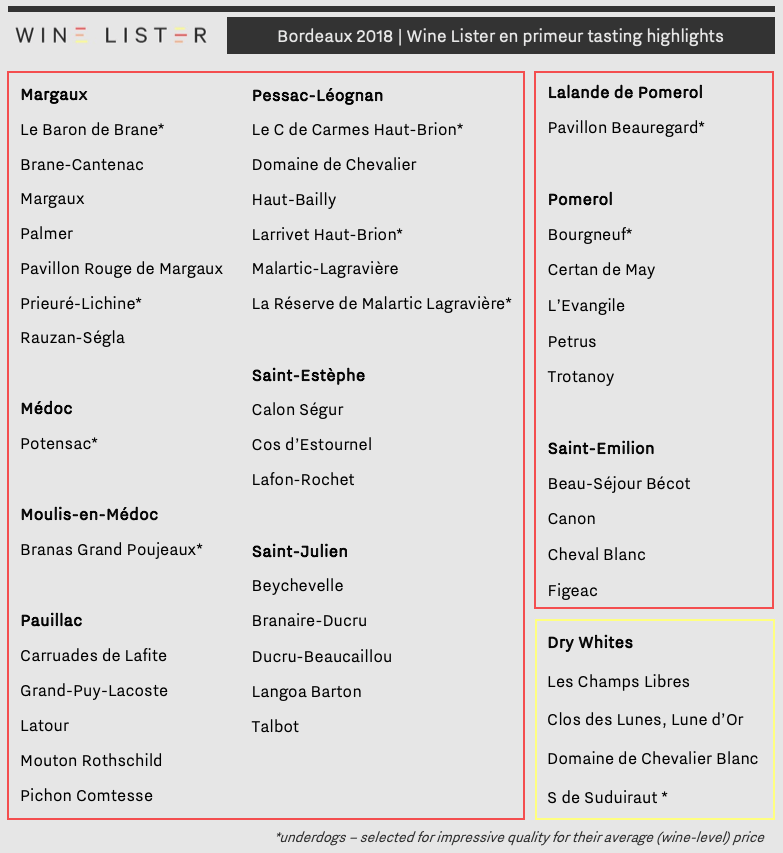
The Wine Lister team found beautiful wines in all the left bank appellations. Margaux and Pessac-Léognan appeared the most consistent for high quality, earning seven and six highlights respectively. These two appellations are home to five of Wine Lister’s 10 underdogs of 2018 en primeur tastings.
The former includes its first-growth namesake, Château Margaux, which was precise, addictive, and harmonious. Pavillon Rouge de Margaux also made the cut thanks to its intriguing and soft fruit character. Brane-Cantenac is becoming a Wine Lister staple after appearing in both 2016 and 2009 tasting highlights. Its 2018 was pure, fresh, and a perfect balance between power and finesse.
In Pessac-Léognan, Domaine de Chevalier had piercing intensity balanced with a floral softness, while Haut-Bailly impressed with a playful fruit character and velvet texture.
Elsewhere on the left bank, Branas Grand Poujeaux surprised with its classy, energetic, dark fruit. Pauillac produced examples of intense fruit handled with a delicate touch (Grand-Puy-Lacoste and Pichon Comtesse). Saint-Estèphe presented beguiling wines with great freshness and elegance (Cos d’Estournel). Saint-Julien showed depth of flavour and complexity in equal measure (Langoa Barton, Ducru-Beaucaillou).
The right bank was just as impressive, with an equal proportion of highlights for Wine Lister as the left (in each case, 19% of wines tasted made the cut). These include one underdog (and new discovery for Wine Lister) from Lalande de Pomerol, five stand-outs from Pomerol, and four from Saint-Émilion.
In Pomerol, Petrus was alluring, generous, and floral, while Trotanoy had delicate strength and never-ending energy. Saint-Émilion produced favourites of varying styles, including Cheval Blanc – a magical, mesmerising boudoir-style wine, and Canon – dancing, racy, and fresh.
Readers should note that these 42 wines are some of the team’s favourites from last week’s tastings, but that we will be releasing official Wine Lister Buys throughout the campaign as prices become known. WL Buys take into account a wine’s quality (based on our partner critics’ scores, which we look forward to adding as soon as they are released), and value within the vintage and appellation, as well as Wine Lister’s personal opinion based on our own tastings and market insights.
Trade members wishing to gain full access to Wine Lister’s en primeur campaign coverage will need to subscribe to Wine Lister Pro. Register your interest here.
This week’s “top five” blog is a first for Wine Lister, as we analyse the highest-Quality wines of a single producer, Michel Chapoutier. Readers should note that this is simply an analysis exercise, and not a paid advertisement (albeit a shining review of Chapoutier, given how high the Quality scores are).
In first place of this week’s top five, perhaps surprisingly, is a white wine – Chapoutier’s Ermitage Blanc L’Ermite, with a Quality score of 966. Not only does this make it the highest-quality white Rhône on Wine Lister, but also the second highest-quality wine from the Northern Rhône overall, beaten only by Jean-Louis Chave’s Hermitage Cuvée Cathelin. The 2015 earns 94-96 points from Wine Lister partner critic, Vinous, with Josh Raynolds commenting on its “outstanding focus and persistence”. While outperforming its siblings for Quality, it also earns the highest average price of the group, at over £300 per bottle in-bond.
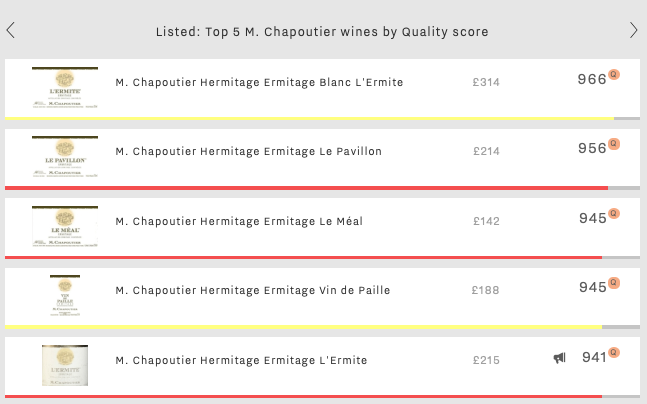
Next up is the first red of the group, Ermitage Le Pavillon, with a Quality score of 956. Wine Lister partner critic, Jancis Robinson, awards the 2016 vintage an impressive 19 points, naming it a “polished and pure Hermitage”. It also earns the group’s best Brand score of 897, appearing in 15% of the world’s best restaurants and ranking in 266th place for Wine-Searcher searches among the c.4,000+ wines on Wine Lister.
In joint-third place comes the second red of the group, Ermitage Le Méal, and Chapoutier’s sweet white, Ermitage Vin de Paille. Both achieve a Quality score of 945, however they are distinctive not just in their respective styles, but also in their Brand scores. Le Méal is clearly the better-known, with a Brand score of 724 and a search rank of 710, compared with the Vin de Paille’s Brand score of 593 (the lowest of this week’s top five), and a search rank of 2088. Interestingly however, the Vin de Paille’s presence in the world’s top restaurants is the better, if only by 1% (6% vs. 5% for Ermitage Le Méal).
Rounding out Chapoutier’s top five for Quality is the Ermitage L’Ermite, with a Quality score of 941. Despite its position at the bottom of the group, it achieves the highest Quality score at vintage level for the 2010 (992). The Ermitage L’Ermite 2010 achieves 95+ points from Wine Lister partner critic, Vinous, and though Josh Raynolds calls it “remarkably long, chewy, smoke- and spice-accented…”, he also warns it “should be stashed away and forgotten for a good long while”.
Château Latour has released a parcel of their 2008 this morning. It is being offered in the UK at c.£425 per bottle. The factsheet below summarises its key points.

You can download this slide here: Château Latour 2008
Wine Lister recently analysed the Bordeaux 2009 vintage in two parts. The first – a tasting and subsequent selection of top picks by Wine Lister’s founder, Ella Lister, revealed sublime quality across both banks. The second – a two-page analysis of the vintage overall – reveals that alongside top quality, prices of Bordeaux 2009s are high, and it is therefore all the more difficult to find good value, particularly among the left bank’s classified growths.
With this in mind, our Listed: top five blog this week explores the highest-quality Bordeaux fifth growths from the 2009 vintage. Despite the great quality across appellations, all five hail from Pauillac. They are all also Wine Lister Buzz Brands.
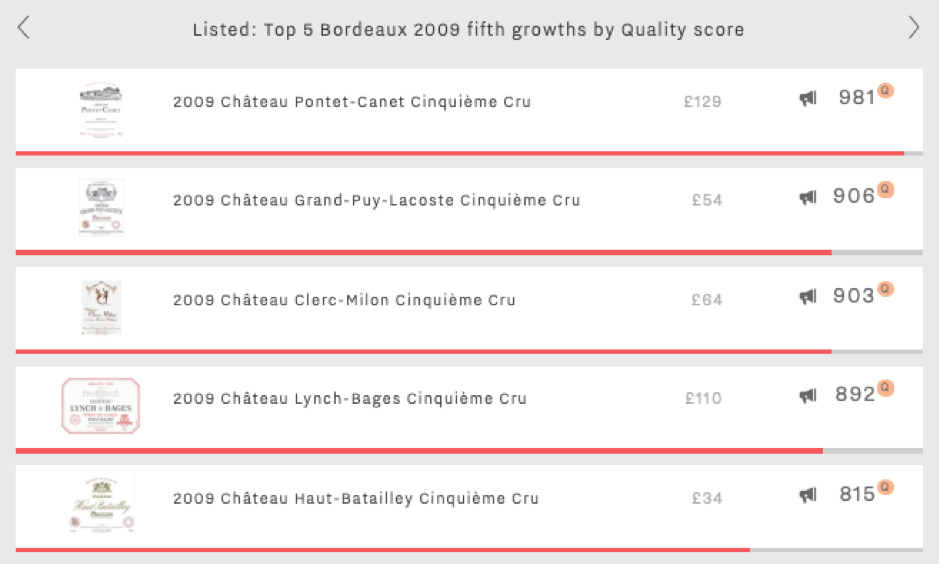
In first place is Pontet-Canet 2009. Its Quality score of 981 sits a full 102 points above the average of the other four wines in this week’s top five. This presumably contributes to its price of £129 per bottle in-bond – the highest of the group.
Next is Grand-Puy-Lacoste 2009, with a Quality score of 906 and the second-lowest price of this week’s top five (£54 per bottle in-bond). It is the only one of the group to appear among top picks from the recent 2009 re-tasting.
Just three points behind Grand-Puy-Lacoste, in third place, is Clerc-Milon 2009. In the economics department it outperforms the rest of the group significantly, with an Economics score of 905 and a compound annual growth rate (CAGR) of 17.3% – over two and a half times higher than the average of the other four wines in this week’s top five.
This week’s last two wines now fall under the same ownership, that of the Cazes Family. Nonetheless, the 2009 vintages of Lynch-Bages and Haut-Batailley, which achieve Quality scores of 892 and 815 respectively, present quite different profiles. Lynch-Bages is this week’s “brand king” with a Brand score of 996 – the highest of this week’s top five – and a price of £110 per bottle in-bond. Though Haut-Batailley 2009 achieves a Quality score 7% lower than Lynch-Bages, its price of £34 is 69% lower than that of its sibling, therefore providing exceptional value. After the acquisition and subsequent repositioning of Haut-Batailley through its 2017 en primeur release, it will be interesting to see how both châteaux fare in the upcoming 2018 campaign.
Wine Lister’s founder, Ella Lister, was in Burgundy last week and gained insight into how the 2018 vintage is shaping up. Benjamin Leroux explained that Burgundy is “getting used to picking in August”. He says that grapes picked early enough in 2018 are “showing amazingly”.
With the potential of another superb vintage under Burgundian belts, this week’s top five examines the region’s best whites by Wine Lister score. Unsurprisingly, the quality of these five wines is extremely high, their brand strength is well-established (all five are Wine Lister Buzz Brands), and the prices are eye-watering (with an average per-bottle price of over £2,500).
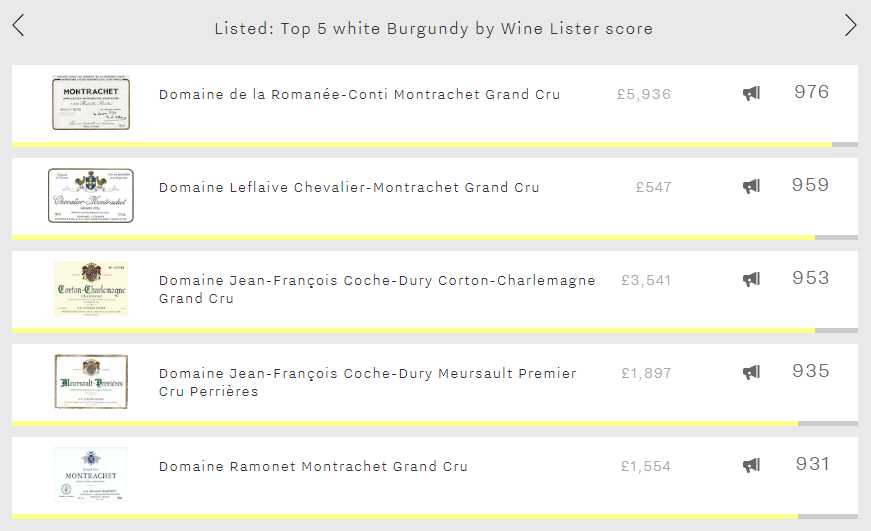
In first place of this week’s top five with a score of 976 is Domaine de la Romanée-Conti’s Montrachet. Sweeping up the top spots across all three Wine Lister score categories, Quality (978), Brand (964), and Economics (992), it is hard to fault the top white offering from arguably the world’s most famous, and exclusive, wine estate.
Next is Domaine Leflaive’s Chevalier-Montrachet. It stands out amongst this week’s top five with a market price of £547, or just 17% of the average of the remaining wines in the group. While the all-white-producing domaine earns Buzz Brand status for its Chevalier-Montrachet, its highest-scoring wine for quality is actually the Montrachet, with a Quality score of 985. Sitting 18 points above the Chevalier-Montrachet, it also comes with a much larger price tag of c.£6,500 per bottle in-bond.
Third and fourth places in this week’s top five are occupied by the same producer – Jean-François Coche-Dury. The domaine’s Corton-Charlemagne actually comes in second of the group for quality, with a Quality score of 971, just six points behind Romanée-Conti’s Montrachet.
Coche-Dury’s Meursault Perrières is very close behind, sporting a Quality score of 959. The only Meursault to feature in this week’s top five, Wine Lister partner critic Antonio Galloni names the 2009 vintage – its highest-scoring in the last 10 years – “pure seduction” and “insanely beautiful”. The Meursault Perrières does not live up to these surrounding grands crus in quality alone – it also comes at a four-figure sum per bottle (of almost £2,000 in-bond).
Finally, in fifth place is Ramonet’s Montrachet, with an overall score of 931. Despite earning this week’s least-strong Quality score of 958, it wins the number one spot for long-term ageing, with an average wine life of 19 years – seven years longer than the average of the remaining four wines of the group. A wine to lay down then, and it also has impressive long-term price performance – the second best of the group after DRC’s Montrachet, with a compound annual growth rate of 27.7%.
Price and price performance have been hot topics for Wine Lister’s recent blog posts across several regions (Burgundy, Champagne, Tuscany). The Rhône Valley flies further under the radar than these as a region for investment, perhaps in part because its two distinct vineyard areas – North and South – are too different to be cast under the same umbrella. This week’s top five examines the highest prices in the Northern Rhône.
In first place is Domaine Jean-Louis Chave’s Hermitage Cuvée Cathelin. With an average price of £5,248 (per bottle in-bond), it is almost 20 times more expensive than the average of the other four wines in this week’s group. The small quantity of wine, made only in the best years, combined with a Quality score of 977 – the best of this week’s top five – go some way to explaining the four-figure price tag. (Interestingly, the most expensive wine in the Southern Rhône, Buzz Brand Château Rayas’ Chateauneuf-du-Pape, costs an average of £478, or just 9% of the Cuvée Cathelin).
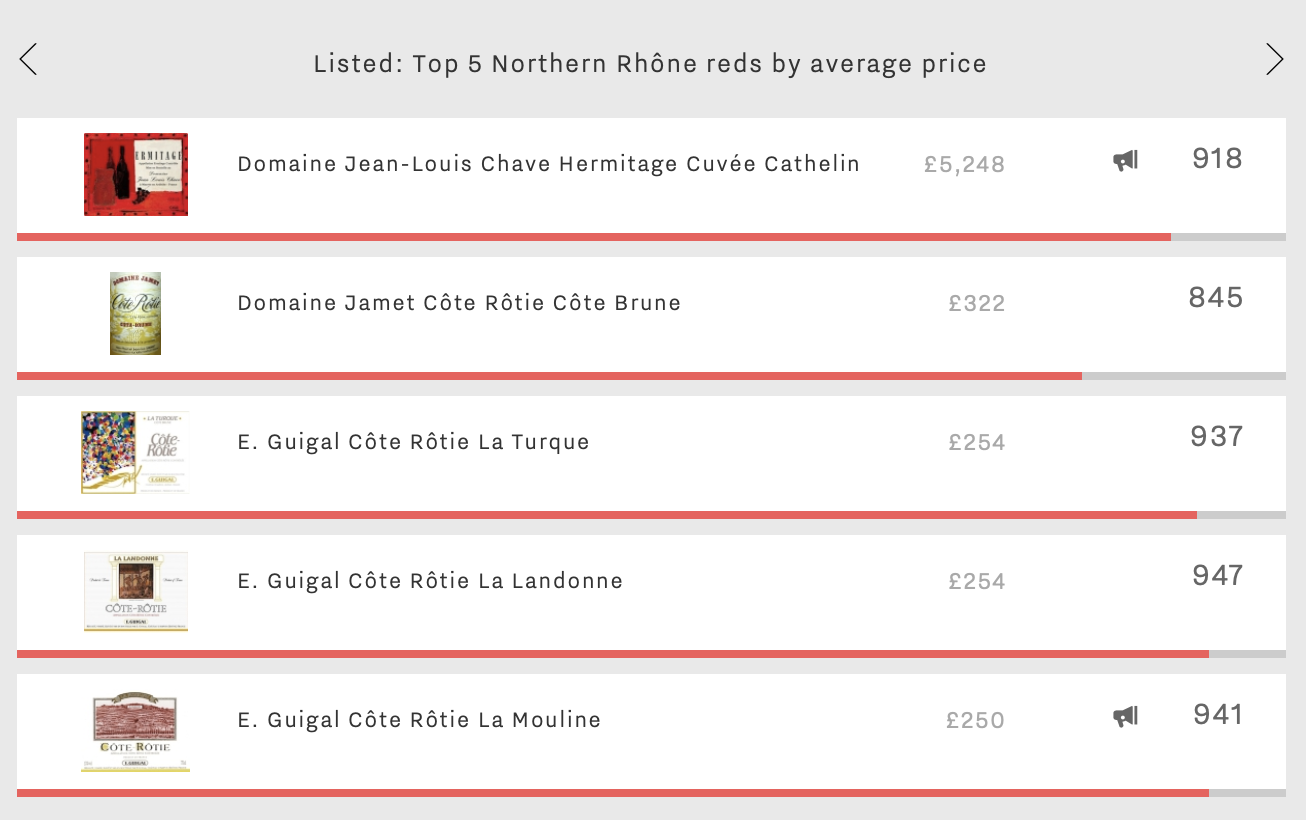
Back in the Northern Rhône, the next of this week’s top five is Domaine Jamet’s Côte Rôtie Côte Brune. Although £4,926 less expensive than this week’s number one, at £322 per bottle in-bond, it actually achieves the best three-year price performance, with a compound annual growth rate (CAGR) of 24.7%. With an average production volume of just 2,400 bottles per year, it is perhaps unsurprising that the wine’s Brand and Economics scores (at 763 and 759 respectively) are lower than its Quality score (946), as it appears in only 8% of the world’s best restaurants, and just three bottles were traded at auction internationally last year.
The remaining wines of this week’s top five hail from the same producer, Guigal, and come as a trio affectionately-known to the trade as “La-Las”. Though close together in price, it is interesting to see the subtle differences between these three Côte Rôtie across Wine Lister’s 13 score criteria.
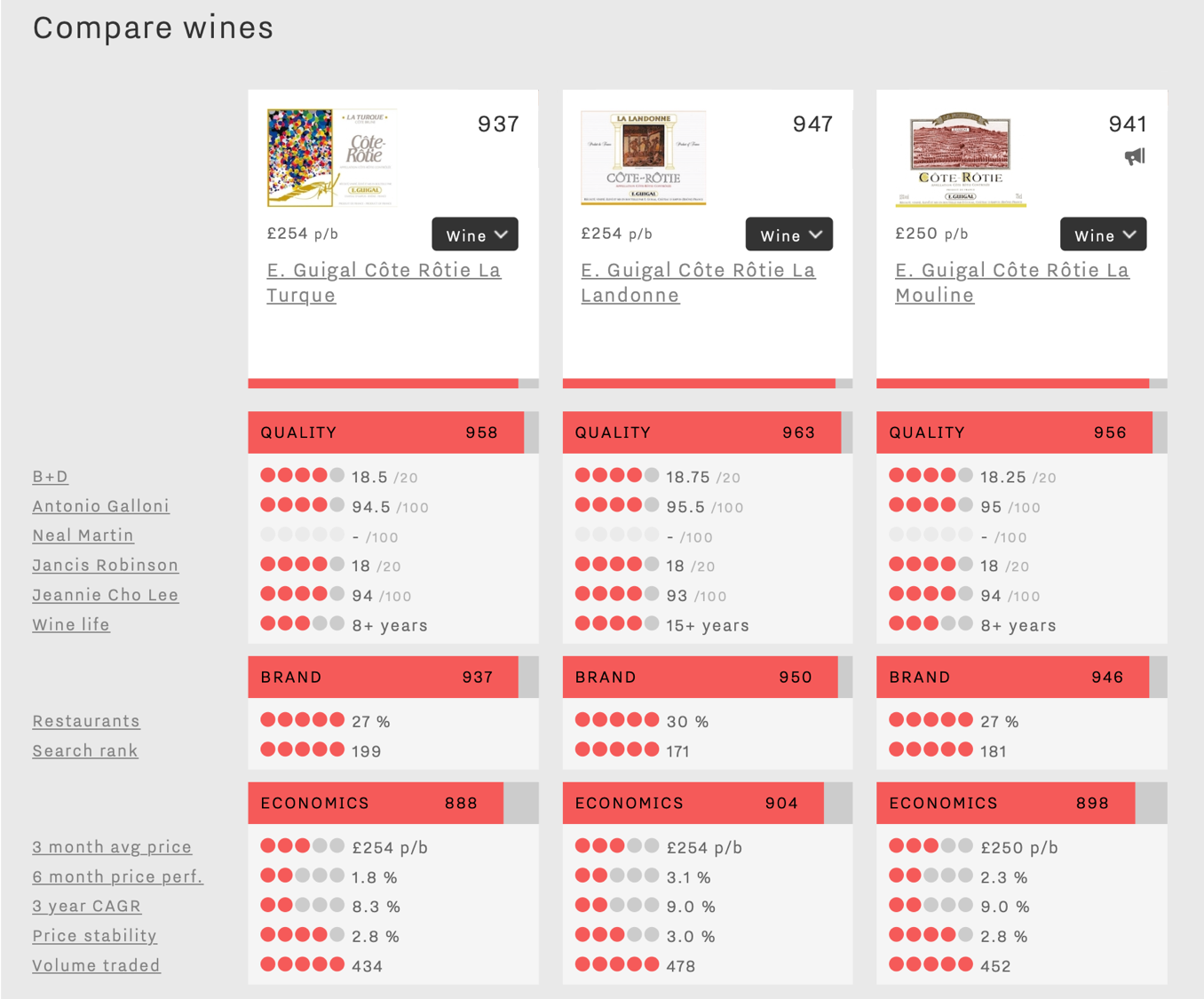
The chart above, created using Wine Lister’s Comparison tool, proves La Turque to be the lowest-scoring of the three overall. It shows slightly less demand with a lower search rank of 199 out of the c.4,000 wines on Wine Lister, whereas its siblings earn more monthly searches on Wine-Searcher. It also under-performs against the other two in economic terms, with lower long- and short-term price growth, and fewer bottles traded annually at auction.
By contrast, La Landonne achieves the top Quality score of 963 (and an average wine life just under twice that of its siblings), the best brand strength, and the highest average number of bottles traded annually at auction (478).
While La Mouline has the lowest average price of the three (£250 per bottle in-bond), it is the only one to earn Wine Lister’s Buzz Brand stamp, and achieves the joint-best three-year price performance with La Landonne – a CAGR of 9%.
With our founder, Ella Lister, just back from tasting the latest releases at Benvenuto Brunello in Montalcino, we thought we’d dig deeper into the data behind the appellation’s top wines. The pyramid system in the region means that most producers make at least three wines: in the middle, a Brunello di Montalcino DOCG Annata (or “vintage”); in good years, a Riserva (with longer ageing but also nearly always the best selection of grapes from the estate); and at the bottom of the pyramid, a Rosso di Montalcino DOC, producing fresher, approachable wines requiring less ageing.
This allows, and indeed encourages, a healthy level of selection in the region. At last weekend’s event, the vintages on show were 2013 Brunello Riserva (excellent), 2014 Brunello Annata (a tricky vintage, with some producers declassifying to Rosso di Montalcino), and Rosso di Montalcino 2017. There is also a trend in the Brunello DOCG towards vineyard-specific crus, such as Casanova di Neri’s Tenuta Nuova or Il Marroneto’s Madonna delle Grazie, both of which feature in this week’s top five: top Brunellos by Economics score.
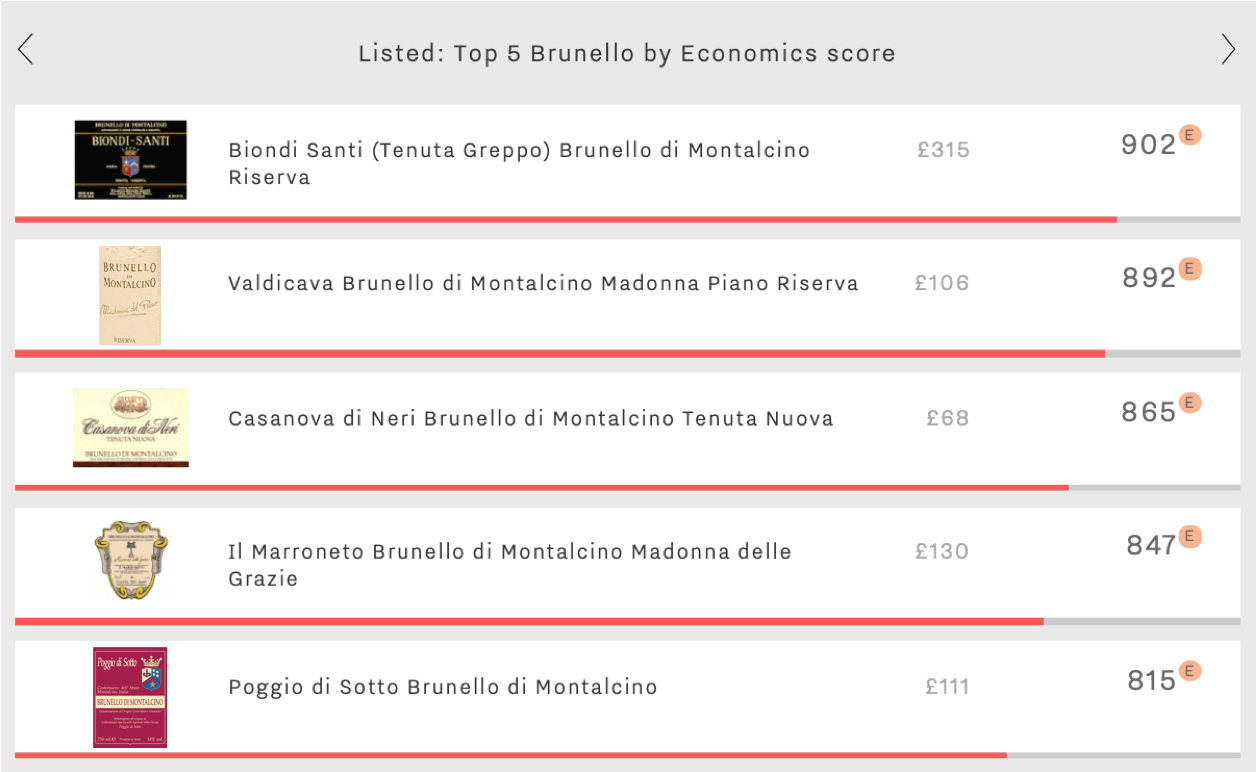
When examining the economic profile of Brunello wines, we see that Riservas tend to have higher Economics scores than Annatas, in line with their higher Quality scores. The best-performing Brunello by Economics score is Biondi Santi’s Brunello di Montalcino Riserva, with a score of 902. It earns the number one spot of this week’s top five with the highest price at £315 per bottle in-bond, and annual auction trading volumes of 458 bottles. The wine also outperforms the rest of the group for both Brand and Quality scores (904 and 938 respectively).
While Riservas are strong economically speaking, Annatas often have stronger Brand scores than their longer-aged counterparts, being produced in larger quantities and thus achieving greater visibility. In second place is Valdicava’s Brunello di Montalcino Madonna Piano Riserva, with an Economics score of 892, whereas its straight Brunello has a Brand score 57 points above its “big” brother, an example of the potential branding conundrum surrounding Brunello and other parts of Tuscany with a Riserva denomination. Nonetheless, the Riserva shows better price performance, with a compound annual growth rate (CAGR) of 15.2%, and an average of 257 bottles sold at auction annually.
Specific “crus” can also perform better than their straight Brunello Annatas in economic terms. In third place is Casanova di Neri’s Brunello di Montalcino Tenuta Nuova with an Economics score of 865. Despite having the lowest Quality score (841) and lowest price (£70) of the group, it earns this week’s second-highest Brand score (887).
In fourth place is Il Marroneto’s Brunello di Montalcino Madonna delle Grazie, the winery’s top cru, produced from grapes grown around the historic chestnut flour store house, and below the church by the same name. It has an Economics score of 847, benefitting from by far the best long-term price performance of this week’s top five, with a compound annual growth rate (CAGR) of 22.9%. Moreover, it sits just one point shy of this week’s number one in Quality terms (937) at 40% of the price – £130.
Rounding out the group is Poggio di Sotto’s Brunello, with an Economics score of 815.
While Super-Tuscans have been recognised for their investment potential for some time, Brunello still sits rather in the shadow of its Bordeaux-blend brothers. In Wine Lister’s first Tuscany market study, conducted in 2017, Brunello held nine places out of the top 25 Tuscan Economics scores. Today that number has increased to 14, as Brunello – Montalcino’s very own, highly ageworthy selection of the Sangiovese grape – goes from strength to strength.
At the end of last year, Wine Lister released its first ever Champagne report. As well as exploring a handful of key trends as identified by Wine Lister’s Founding Members, the report also sheds light on top Champagnes as compared to other regions in terms of economic performance.
Prices of the top Champagnes (Dom Pérignon, Krug Vintage, Louis Roederer Cristal, Salon Le Mesnil and Dom Pérignon Rosé) have seen a compound annual growth rate (CAGR) of 4.8% over the last six years. Relative to other major fine wine regions, this long-term growth is slow, as shown in the chart below, but also stable.

One notable advantage of Champagne as an investment option it its low volatility. Indeed, Champagne prices show a much better level of stability in the secondary market (deviating by just 2.5% from the average price over 12 months) than any other major fine wine region. Slow and steady wins the race.

Moreover, recent price performance shows Champagne accelerating. Prices of top Champagnes are starting to grow at a faster rate than their counterparts in California, Bordeaux, and Tuscany, beaten only by Piedmont and the seemingly unmatchable Burgundy. Indeed, as of December 2018 top Champagnes had seen a 12-month price growth of 11%. The region’s potential for long-term investment is already being acknowledged by the trade, with one of our Founding Members, a top tier UK merchant commenting “Champagne (Salon especially) has experienced solid growth and has become a reliable investment for collectors”.
Salon Le Mesnil is the number one performing Champagne for price performance, with an Economics score of 978, closely followed by Krug’s Clos d’Ambonnay (962). Krug also tops the Champagne Economics charts with its Clos du Mesnil, Brut Vintage, and Collection. Interestingly the only NV Champagne to appear within the top 10 Champagnes for Economics is grower Jacques Selosse’s Brut Initial, with an Economics score of 911. Its price, £106 (per bottle in-bond), is a mere 18% of the average price of the other nine top Champagnes by Economics score.
To read more key findings from our in-depth Champagne study, read the free summary here. (The key findings and full study are also available to download in French on the Analysis page.)
Wine Lister is experiencing a touch of Bordeaux fever. Having re-tasted Bordeaux 2016s in January, Wine Lister’s founder, Ella, attended BI Wines’ “10 years on” tasting last week, revisiting the iconic 2009 vintage.
As expected, the vintage yielded some truly exceptional wines, thanks to excellent weather conditions, especially around harvest time. However, some producers fell into the trap of waiting too long to pick, and high quality in 2009 is not a given. Ella has picked out 26 of the most successful examples of a unique and pleasure-giving vintage, hailing from across all of the best-known red wine Bordeaux appellations (N.B. no white wines were tasted).
The most heterogenous appellation was Saint-Emilion, with some wines rendered hot and hard by high alcohol, while those at the very top level were some of the best 2009s out there. Cheval Blanc, for example, achieved a “mystical, beguiling bouquet…like a magic potion”.
Pomerol did not seem to suffer from the heat in the same way, and made beautiful wines in 2009. Perhaps unsurprisingly, Le Pin garnered some exceptional comments, including “the richest, most decadent, abundant nose of the whole tasting”. Other Pomerol picks displayed an unusually dark-fruited character. Petrus (“not worn on the sleeve like the Le Pin”), had a “refined dark fruit character”, Hosanna “piercing damson fruit”, and La Conseillante boasted a “carnal, purple-fruit sweetness”.
On the left bank, Pessac-Léognan and Saint-Julien achieve joint-first place, earning five highlights each. Arguably the most impressive of these were La Mission Haut-Brion and Haut-Brion with the former described as “sensual, ethereal, and breath-taking”. Pape Clément showed almost “Rhône-esque animality”, while Malartic-Lagravière was “opulent” and “left you wanting more”.
Saint-Julien presented expected names – second growths Gruaud-Larose and Léoville Barton (described as “ultra-classical” and “thoroughbred” respectively), as well as a surprise in the form of Château Gloria, the only Cru Bourgeois to make it into this list of Bordeaux 2009 tasting highlights.
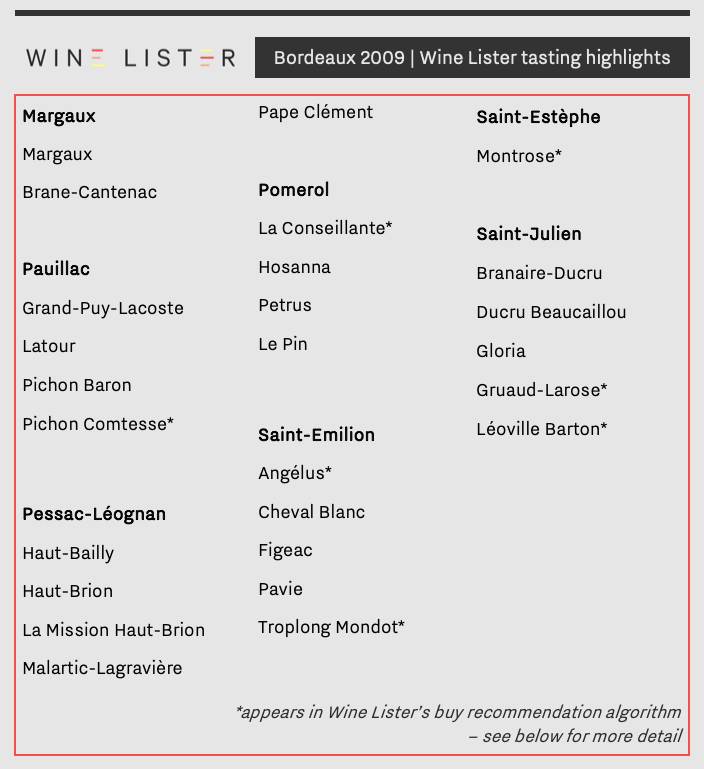
The remaining left bank appellations did not go wanting of favourites. Latour earned the comment, “impeccably turned-out, this wine demands attention”. Elsewhere in Pauillac Pichon Comtesse was “beguiling” and “gradually confident”.
In Margaux the appellation’s first growth namesake was hailed “quite the showstopper”, while Brane-Cantenac was “lifted, lovely, and luminous”. While Saint-Estèphe earned only one mention, its representative, Montrose surpassed expectation, appearing “supremely poised”.
All those wines marked “*” above currently qualify as Wine Lister “buy recommendations”. The Wine Lister team has been working hard to create a data-driven list of the ultimate best wines to buy – watch this space while we fine-tune the algorithm!
Other wines featuring in the Bordeaux 2009 highlights are: Grand-Puy-Lacoste, Pichon Baron, Haut-Bailly, Angélus, Figeac, Pavie, Troplong Mondot, Branaire-Ducru, and Ducru Beaucaillou.
 Happy with their 2018s: Guillaume Pouthier, Pierre-Olivier Clouet, and Nicolas Glumineau
Happy with their 2018s: Guillaume Pouthier, Pierre-Olivier Clouet, and Nicolas Glumineau









